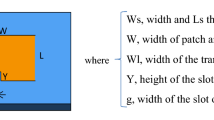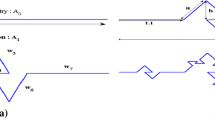Abstract
In this paper, a novel approach in Microstrip Patch Antenna analysis and design has been introduced. Here, a low-profile fractal microstrip antenna has been presented. ‘Sierpinski Triangular’ fractal geometry has been applied in the designing the antenna. Evolutionary Particle Swarm Optimization technique has been utilized for optimizing the design parameters. Triangular slots have been etched in the ground plane, repeated in the subsequent iterative stages. An inverted triangular patch has been placed on top of almost 1.00 mm thick Roger 4350 substrate having an electrical permittivity of 3.48 and loss tangent of 0.004. The antenna resonating frequency is 3.5 GHz with an impedance bandwidth of 700 MHz. The antenna finds its application in 3.5 GHz WiMAX band with a maximum gain of 3.34 dBi and return loss factor of 24 dB at the resonant frequency, which is reasonably better than conventional microstrip patches.
Access provided by Autonomous University of Puebla. Download conference paper PDF
Similar content being viewed by others
Keywords
1 Introduction
The need for compact-sized antenna is increasing day by day. Modern communication world is fully dependent on Microstrip Patches embedded in mobile devices. A major disadvantage of Conventional Patch Antennas is low bandwidth and high return loss factor. In recent times, Fractal Shapes are being introduced in Patches for bandwidth improvement and minimizing the return loss factor. The advantages of Fractal Shapes have been studied from the available literature [1, 2]. In this paper, a novel approach in Microstrip Patch Antenna analysis and design has been introduced. Here, a low-profile fractal microstrip antenna has been presented. ‘Sierpinski Triangular’ fractal geometry has been applied in the designing the antenna. Evolutionary Particle Swarm Optimization technique has been utilized for optimizing the design parameters. Triangular slots have been etched in the ground plane, repeated in the subsequent iterative stages. An inverted triangular patch has been placed on top of almost 1.00 mm thick Roger 4350 substrate having an electrical permittivity of 3.48 and loss tangent of 0.004. The antenna resonating frequency is 3.5 GHz with an impedance bandwidth of 700 MHz. The antenna finds its application in 3.5 GHz WiMAX band with a maximum gain of 3.34 dBi and return loss factor of 24 dB at the resonant frequency, which is reasonably better than conventional microstrip patches. The shape and size of the antenna is kept compact so that it can easily be incorporated in wireless devices.
2 Antenna Design
The antenna has been designed in IE3D Software (MoM based) environment. The front and rear views of the proposed structure have been shown in Fig. 1. The small compact rectangular-shaped patch has a dimension of W × L = 31.25 × 37.75 mm. The antenna consists of an inverted triangular-shaped patch. The altitude of the triangle has been specified as l3. The feed length and feed width have been specified as l1 and l2, respectively. The ground plane consists of four Sierpinski triangular slots. There is a triangular slot in the centre of the ground plane. The centre triangular slot is surrounded by three other triangular slots at each side of the centre triangle. The dimensions of the triangular slots are specified by S1 and S2, which are related as
and l1 and l2, the patch dimensions are related as
The parameter dimensions of the antenna are specified in Table 1. The feed line width should be carefully chosen in order to match the impedance and transfer of maximum power from the transmission line section to the radiating structure. An optimized feed width (l2) of 2.50 mm has been chosen for impedance matching and transmission of maximum power to the patch and minimization of return loss factor. The optimization process has been discussed in the following section.
3 PSO and Its Application in Antenna Design
Particle Swarm Optimization or in short PSO is a very popular and efficient optimization algorithm. The concept was originated from a very common event observed in nature. Feather flopping of birds is a very common event observed daily. The idea was to represent it in a graphical pattern. Later, an algorithm was formulated using a satisfactory solution which can be obtained for real-time complex computational problems. The solutions, here, are termed as ‘Particles’. The best or the fittest value of the solution is regarded as the pbest. The overall best value, tracked by the global version of swarm and whose location is known, is called as the gbest. The moto is to obtain these pbest and gbest values of the solutions and drive the problem towards an optimum direction.
The following stages explain the implementation process of PSO:
-
1.
First, an initial population is selected for particles with random position and velocities.
-
2.
The Fitness Function for each particle is computed next.
-
3.
The pbest (δid) value is compared with the obtained fitness value. If the latter is better, it is selected as the current value for the particular particle.
-
4.
Next, gbest (δgd) value is compared with evaluated best fitness value, and the better result is set equal to the current value.
-
5.
The position (ψm) and velocity (ζm) for each particle are given as
$$ \psi m\; = \;\psi m\; + \;\alpha 1\;*\;rand()\;*\;\left( {\delta id\; - \;\zeta m} \right)\; + \;\alpha 2\;*\;rand()\;*\;\left( {\delta gd\; - \;\psi m} \right) . $$(3)$$ \psi m\; = \;\psi m\; + \;\zeta m . $$(4)where α1 and α2 are the acceleration constants.
-
6.
The process is recycled till desired optimized values are obtained [3,4,5].
The basic antenna parameters, as specified in Table 1, have been optimized using the PSO technique to minimize the return loss factor at the frequency point of interest, i.e. 3.5 GHz.
The proposed Compact Microstrip Patch Antenna (CMPA) has been designed and simulated using few commonly available substrates in the market. The basic objective of the work is to improve the return loss factor |S11| at the resonant frequency, i.e. 3.5 GHz (WiMAX Networks). Selection of a proper substrate material is an important aspect of antenna design. Each and every substrate is characterized by its unique property of electrical permittivity and loss tangent factor. As observed from Fig. 2, FR-4 substrate with an electrical permittivity (εr) of 4.3 shows low return loss factor, but there is a frequency deviation at the frequency of interest, i.e. 3.5 GHz. Duroid with an electrical permittivity (εr) of 2.2 shows a poor response as observed from Fig. 2. On the other hand, Foam with an electrical permittivity (εr) of 1.05 gives an unsatisfactory result. The return loss, |S11| has been improved and the bandwidth has been enhanced using Roger 4350 substrate, having an electrical permittivity of 3.48 and loss tangent of 0.004. The antenna resonating frequency is exactly at 3.5 GHz with almost 700 MHz of impedance bandwidth.
In the following sections, the antenna responses before and after optimization by PSO algorithm has been discussed sequentially along with comparison plots.
There has been an improvement in return loss level by 2 dB (Fig. 3), with the new optimized dimensions. It may be noted that the obtained bandwidth has been kept constant in this regard. The resonant frequency has been kept constant at 3.5 GHz. The minimum return loss factor level |S11| for Roger Substrate, as observed from Fig. 3 is 22 dB. Whereas, after optimization, the return loss has changed to 24 dB. Figures 4 and 5 reflect the improvement in antenna VSWR and realized gain respectively. As observed from Fig. 5, there has been a significant increase in antenna gain.
The Elevation Pattern Gain display for φ = 0° and φ = 90° have been displayed in Fig. 6. The antenna gain has also been reflected from the ‘Elevation Pattern Gain Display’. An idea of the radiation pattern of the antenna can also be obtained from Fig. 6. The min. and max. gain limits are 1.75 and 3.75 dBi as observed from Fig. 6a and Fig. 6b, respectively. The gain is equal to 3.5 dBi at the resonant frequency point, i.e. at 3.5 GHz. Figure 7 shows the antenna surface current distribution pattern at 3.5 GHz. It has been observed that there has been an accumulation of surface current near the slots which is the driving factor for improvements in antenna gain, return loss and VSWR.
4 Conclusion
The above studies reveal that Particle Swarm Optimization has been extremely useful in optimization of the return loss factor at the resonating frequency point. The designed antenna shows quite good and accurate results which justifies its practical applicability. The proposed antenna finds its applicability in 3.5 GHz WiMAX band with a maximum realized gain of 3.5 dBi at the resonant frequency. Also, the compactness and simplicity of the proposed design make it quite suitable to be incorporated in mobile devices supporting wireless communications.
References
Gianvittorio, J.: Fractal Antennas: Design, characterization and applications. Ph.D. Dissertation. Department of Electrical Engineering, University of California at Los Angeles, Los Angeles (2007)
Bhattacharya, A., Roy, B., Chowdhury, S.K., Bhattacharjee, A.K.: Design and analysis of a Koch snowflake fractal monopole antenna for wideband communication. Appl. Computat. Electromag. Soc. J. (ACES) 32(6), 548–554 (2017)
Robinson, J., Rahmat, Samii Y.: Particle swarm optimization in electromagnetics. IEEE Trans. Antennas Propag. 52(2), 397–407 (2004)
Shi, Y., Eberhart R.: Experimental study of particle swarm optimization. In: Proceedings of SCI2000, Conference, Orlando, FL (2000)
Kennedy, J.: Stereotyping; improving particle swarm performance with cluster analysis. Proceedings of the 2000 Congress on Evolutionary Computation, La Jolla, CA, vol. 2, pp. 1507–1512 (2000)
Acknowledgements
The authors express their sincere gratitude to Dr. S. K. Chowdhury, Retired Professor of ETCE Dept., Jadavpur University, Kolkata, India for his constructive comments and suggestions for this work.
Author information
Authors and Affiliations
Corresponding author
Editor information
Editors and Affiliations
Rights and permissions
Copyright information
© 2019 Springer Nature Singapore Pte Ltd.
About this paper
Cite this paper
Bhattacharya, A., De, A., Biswas, A., Roy, B., Bhattacharjee, A.K. (2019). Application of Particle Swarm Optimization in Design of a Low-Profile Fractal Patch Antenna. In: Biswas, U., Banerjee, A., Pal, S., Biswas, A., Sarkar, D., Haldar, S. (eds) Advances in Computer, Communication and Control. Lecture Notes in Networks and Systems, vol 41. Springer, Singapore. https://doi.org/10.1007/978-981-13-3122-0_20
Download citation
DOI: https://doi.org/10.1007/978-981-13-3122-0_20
Published:
Publisher Name: Springer, Singapore
Print ISBN: 978-981-13-3121-3
Online ISBN: 978-981-13-3122-0
eBook Packages: EngineeringEngineering (R0)











